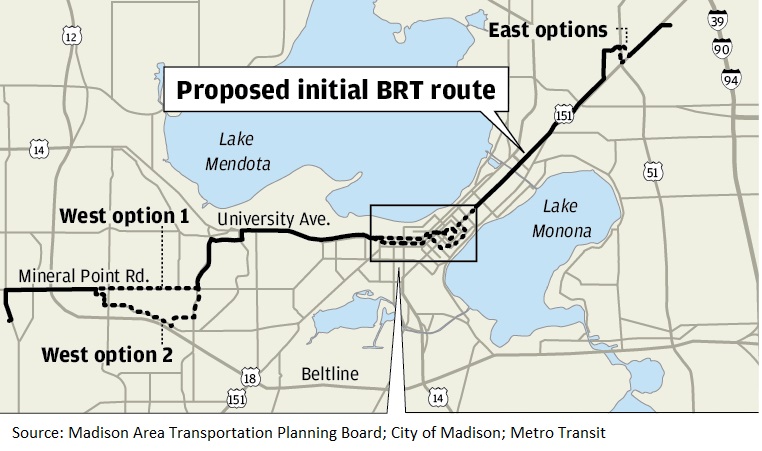Bus Rapid Transit ADDS to Local Bus Service
June 8, 2019 | Susan De Vos

On May 14, 2019 at the downtown Senior Center, the city of Madison had yet another in a series of public meetings on a hypothetical regional transportation system. This time, the meeting was about Bus Rapid Transit (BRT). A video of the meeting can be seen here. and This route [6] operates from West Transfer Point through downtown Madison, to East Towne Mall, with alternating trips serving several different patterns. Existing weekday frequencies are 15 peak/30 midday and evening. Existing weekend frequencies are hourly. It is proposed the eastern portion of this route (east of downtown Madison) be eliminated, replaced with BRT service. [bold added] Lines 22, 27 and 29 would receive similar treatment whereas many other lines would be "modified" but not have major legs amputated. (Appendix I) Since BRT stops much less frequently than the local bus, and would not necessarily travel on the same streets, it cannot simply "replace" the local bus. Rather, such analysis demonstrates a misunderstanding of the distinctive and complementary nature of rapid and local buses. It also sowed confusion and conflation among those who would otherwise know better since its understanding of local buses was obviously quite limited. Is it a surprise therefore that many people seem unaware that the potential of local buses is under-rated? Afer all, if consultants supposedly chosen for their expertise did not know, why should anyone else? A poor understanding of the potential for a good local bus system probably helps explain why the Sustainable Madison Transportation Master Plan (SMTMP) missed the opportunity to upgrade what existed. Better known as the Madison in Motion plan that came out in 2017 and is now the transportation element of Madison�s Comprehensive Plan, the initial intent of the SMTMP project back in 2012 was to upgrade our local bus system. The local system was attempting to maximize coverage but in doing so had become so inconvenient that only a captive audience would ride many of the lines. The expectation was that a redesign could keep most of the bus stops on relevant routes while using straighter, more grid-like paths. Using the same resources, it could have:
Perhaps the experience of Anchorage, AK is most informative because of its similar size and harsh winters. Regarding their bus revamp of 2016-2017, one reads:
Increased frequency and rapidity did not necessitate BRT, just a different design of the local system. But instead of making needed design changes in Madison too, Madison in Motion focused on designing new, and what will probably become segregated, Transit Oriented Developments at hypothetical Bus Rapid Transit stations. The nuance involved in recognizing the distinctive and complementary roles of rapid buses and upgraded local transit service appears to have been lost.
Given the present political climate and uncertainty surrounding the acquisition of needed resources for establishing and operating a starter BRT line, it makes sense to consider an inferior way to have rapid buses as a "fall-back" plan. "Express" buses that operate in regular traffic but stop less frequently than a regular bus could be in order. Metro’s now-retired head planner had actually posed this option over a decade ago, and Metro already runs a few such buses (routes #29, 56 and 57 for instance). It could run more, especially at peak times. To a user, a convenient ride is much more important than whether the bus stops at a BRT station or a regular bus stop. |